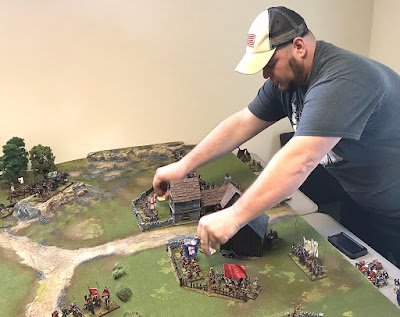"Are you ever going to finish blogging about your Ireland trip?"
"What? Didn't I finish it? That was a year ago..."
"Didn't you go the Boyne?"
"Son of a..."
So, yes. Roughly one year ago I took a trip to Scotland to play some games with toy soldiers and then on a boy's adventure outing to Ireland (you can find the other installments here). Barry Hilton, Bob Talbot, and I trekked through the old city of Londonderry, explored Enniskillen, and climbed fences to walk the battlefield of Aughrim. On the last day of our trip, we did indeed go to the Boyne. We drove up from Mullingar after a Full Irish Breakfast (note... White Pudding is neither white, nor pudding) and were joined on our excursion this day by Paul Patrick...
The battlefield was the first one on the trip that resembled an American site, with a welcome center, cafe, and a small museum. However, besides a small field around Oldbridge, the land is still in use for farming and pastures and we would once again be climbing fences to get to access to different areas.
Very quickly, for those who stumble on this site unaware, the Battle of the Boyne took place in 1690 between the armies of King James II and King William III near the town of Drogheda in Ireland. For a brief introduction you can read the cliff notes here.
I had really been looking forward to this as the armies I am collecting are mostly based on those that fought around Oldbridge, Grove Island, and Yellow Island...
We started at the museum, most of which didn't allow photography except in the yard...
That's Paul Patrick behind the wagon, which should look familiar to fans of Warfare Miniatures. Umm... the wagon should look familiar, not Paul...
Then we wandered down to the site where the hamlet Oldbridge once stood. It was the strong point for the Jacobite defense. Ironically, you can't actually see the Boyne from the site now because there is a thick stand of trees to the north, between it and the river. The open fields south of Oldbridge were the site of repeated Jacobite cavalry charges against the Williamite troops struggling across the river and now form the front lawn of the welcome center...
The last photo is a bit southwest of Oldbridge and is most likely the position held by the Jacobite reserves. All four photos show a sharp ridge and that was where we hiked next, heading away from the Boyne in the direction the retreating Jacobites would have travelled.
Beyond the ridge the land slopes away to the southeast and that highland on the horizon is Donore Hill, where the Jacobite dragoons and assorted other remnants set up a holding action that allowed the rest of the army to escape to Duleek. Just look at the photo for a few minutes and think about running to that hill. Now add a thousand sword wielding soldiers in pursuit mounted on monsters about the weight of a modern smart car. We were amazed any of King James' army survived. More on Donore and Duleek in a future installment...
What? Yes, soon... seriously...
We climbed down the ridge and headed back to the north. We crossed through a fence to a narrow road, and on to Obelisk Bridge - here I had my first real view of the Boyne River (on the bridge, facing west)...
We crossed the bridge and clambered down the steep shoulder to stand on the spot (or very close to it) where William's Dutch Guard launched their assault on Oldbridge.
Heh, I took about thirty photographs of the spot because I knew the cover of The War of Three Kings was going to feature the crossing. I drew the sketch on the plane ride across the ocean...
...and ended up with this...
I tried to get Barry and Bob to wade across so I could get references for the way the water would foam around the soldiers, but they were decidedly unhelpful. Oh, well...
More on the Boyne in a few days...






























































